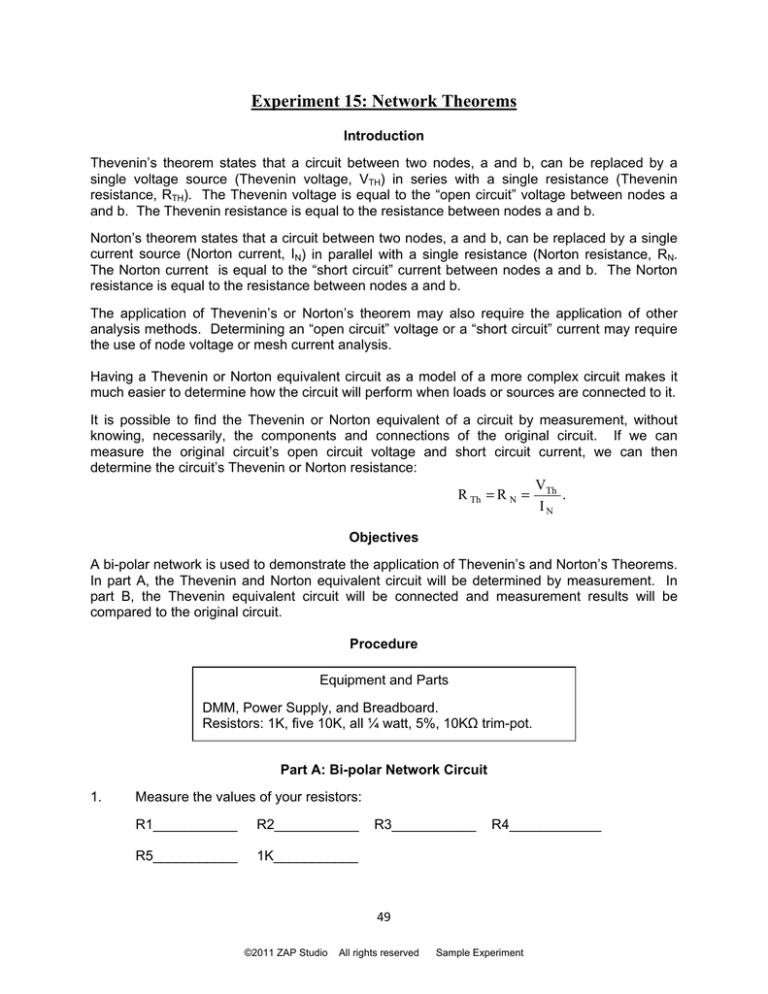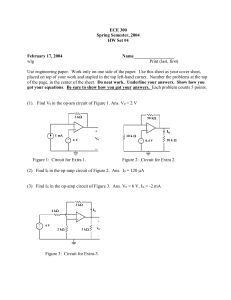
Experiment 15: Network Theorems
Introduction
Thevenin’s theorem states that a circuit between two nodes, a and b, can be replaced by a
single voltage source (Thevenin voltage, VTH) in series with a single resistance (Thevenin
resistance, RTH). The Thevenin voltage is equal to the “open circuit” voltage between nodes a
and b. The Thevenin resistance is equal to the resistance between nodes a and b.
Norton’s theorem states that a circuit between two nodes, a and b, can be replaced by a single
current source (Norton current, IN) in parallel with a single resistance (Norton resistance, RN.
The Norton current is equal to the “short circuit” current between nodes a and b. The Norton
resistance is equal to the resistance between nodes a and b.
The application of Thevenin’s or Norton’s theorem may also require the application of other
analysis methods. Determining an “open circuit” voltage or a “short circuit” current may require
the use of node voltage or mesh current analysis.
Having a Thevenin or Norton equivalent circuit as a model of a more complex circuit makes it
much easier to determine how the circuit will perform when loads or sources are connected to it.
It is possible to find the Thevenin or Norton equivalent of a circuit by measurement, without
knowing, necessarily, the components and connections of the original circuit. If we can
measure the original circuit’s open circuit voltage and short circuit current, we can then
determine the circuit’s Thevenin or Norton resistance:
R Th = R N =
VTh
.
IN
Objectives
A bi-polar network is used to demonstrate the application of Thevenin’s and Norton’s Theorems.
In part A, the Thevenin and Norton equivalent circuit will be determined by measurement. In
part B, the Thevenin equivalent circuit will be connected and measurement results will be
compared to the original circuit.
Procedure
Equipment and Parts
DMM, Power Supply, and Breadboard.
Resistors: 1K, five 10K, all ¼ watt, 5%, 10KΩ trim-pot.
Part A: Bi-polar Network Circuit
1.
Measure the values of your resistors:
R1___________
R2___________
R5___________
1K___________
R3___________
R4____________
49
©2011 ZAP Studio
All rights reserved
Sample Experiment
2.
Connect the circuit shown on the right on a breadboard.
Keep track of where your 10K resistors are. Layout the
circuit on the breadboard in the same way it is in the
schematic diagram.
Carefully note the power supply connections, especially
that V1 is positive with respect to ground, and that V2 is
negative with respect to ground.
3.
Measure and record the “open circuit” voltage Vab.
Measure and record Va and Vb. (Vab = VTH)
Vab________
5.
Va_________
Measure and record the “short circuit” current between nodes a and b. Set the DMM to
measure current on the 20mA range. If your meter shows less than 2 decimal digits
after the decimal point, use a lower current range. Connect the positive meter lead to
node a. Connect the negative lead to node b. Note that Iab = IN, the Norton current.
Iab________________
6.
Vb___________
IN = _________________
Calculate and record the Thevenin (and Norton) resistance: RTH = RN = VTH / IN.
RTH_____________________
7.
Connect a 1K “load” resistor between nodes a and b. Measure and record the “loaded”
value of Vab.
VabLoaded __________________
Part B: Thevenin and Norton Equivalent of Bi-polar Network Circuit
1.
Connect the Thevenin equivalent circuit of the bi-polar
network using the values of VTH and RTH from part A of this
lab exercise. Use the 10K pot for RTH by setting its value to
that obtained in part A, step 4.
2.
Set the power supply voltage to the value of VTH you
measured in part A of this lab exercise.
3.
Connect the 1K load resistor that you used in part A of this lab exercise to your Thevenin
equivalent circuit between nodes a and b.
4.
Measure and record the value of VabLoaded. VabLoaded_____________________
5.
Remove the 1k load resistor. Set the DMM to measure current on the 20mA range
(same as in part A). Measure and record the “short circuit” current between nodes a and
b by connecting the DMM between these nodes (positive lead to node a).
Iab________________
Note that Iab = IN, the Norton current.
50
©2011 ZAP Studio
All rights reserved
Sample Experiment
Analysis, Part A
1.
Write and solve the node voltage equations for Va and Vb for the bi-polar network. Be
sure to use the measured values of your resistors. Calculate Vab.
2.
Use a spreadsheet to compare your calculated Va, Vb, and VTH to your measured
values. Calculate the percent error in the measurements compared to the calculations.
3.
Write and solve the mesh equations for the short circuit current, Iab = IN, between nodes
a and b. Use your spreadsheet to compare the result to your measurement by
calculating the percent error. How much of the error would you attribute to meter loading
effect?
Analysis, Part B
1.
Use your spreadsheet to compare the measurements of Vab, VabLoaded, and Iab in part B
to the measurements in part A.
2.
Use your spreadsheet to compare the measurements in part B to the calculations
(theoretical results) in part A.
TI-89 Example: Node Voltage Equations
Use Va = x and Vb = y for convenience. Also, the equations below use 10,000 Ω as the
resistance of all of the resistors. Use your measured values in your equations.
Solve((x-10)/10000+x/10000+(x-y)/10000 = 0 and (y+10)/10000+y/10000+(y-x)/10000 = 0,{x,y})
x = 2.5, y = -2.5 Therefore Vab = VTH = x – y = 2.5 + 2.5 = 5.0V.
TI-89 Example: Mesh Current Equations
Use I1 = x, I2 = y, and I3 = z for convenience. Also, the
equations below use 10,000 Ω as the resistance of all of the
resistors. Use your measured values in your equations.
Loop 1: -10 + 10000 I1 + 10000 ( I1 – I2 ) = 0
Loop 2: 10000 ( I2 – I1 ) + 10000 ( I2 – I3 ) = 0
Loop 3: -10 + 10000 ( I3- I2 ) + 10000 I3 = 0
solve(-10+10000*x+10000*(x-y)=0 and 10000*(y-x)+10000*(y-z)=0
and -10+10000*(z-y)+10000*z=0,{x,y,z})
x = I1 = 1mA, y= I2 = 1mA, z = I3 = 1mA.
Therefore I2 = IN = 1mA.
51
©2011 ZAP Studio
All rights reserved
Sample Experiment





